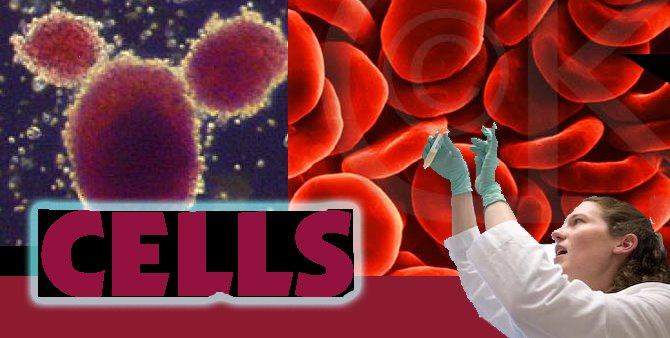
 |
The one-celled organism
amoeba proteus |
 |
A single-celled bacteria
of the type: E. coli |
 |
| A human red blood cell |
 |
A plant cell from the leaf
of a poplar tree |
The cell is one of the most basic units of life. There are millions of different types of cells. There are cells that are organisms onto themselves, such as microscopic amoeba and bacteria cells. And there are cells that only function when part of a larger organism, such as the cells that make up your body. The cell is the smallest unit of life in our bodies. In the body, there are brain cells, skin cells, liver cells, stomach cells, and the list goes on. All of these cells have unique functions and features. And all have some recognizable similarities. All cells have a 'skin', called the
plasma membrane, protecting it from the outside environment. The cell membrane regulates the movement of water, nutrients and wastes into and out of the cell. Inside of the cell membrane are the working parts of the cell. At the center of the cell is the cell
nucleus. The cell nucleus contains the cell's DNA, the genetic code that coordinates protein synthesis. In addition to the nucleus, there are many
organelles inside of the cell - small structures that help carry out the day-to-day operations of the cell. One important cellular organelle is the
ribosome. Ribosomes participate in protein synthesis. The transcription phase of protein synthesis takes places in the cell nucleus. After this step is complete, the mRNA leaves the nucleus and travels to the cell's ribosomes, where translation occurs. Another important cellular organelle is the
mitochondrion. Mitochondria (many mitochondrion) are often referred to as the power plants of the cell because many of the reactions that produce energy take place in mitochondria. Also important in the life of a cell are the
lysosomes. Lysosomes are organelles that contain enzymes that aid in the digestion of nutrient molecules and other materials. Below is a labelled diagram of a cell to help you identify some of these structures.

 There are many different types of cells. One major difference in cells occurs between plant cells and animal cells. While both plant and animal cells contain the structures discussed above, plant cells have some additional specialized structures. Many animals have skeletons to give their body structure and support. Plants do not have a skeleton for support and yet plants don't just flop over in a big spongy mess. This is because of a unique cellular structure called the cell wall. The cell wall is a rigid structure outside of the cell membrane composed mainly of the polysaccharide cellulose. As pictured at left, the cell wall gives the plant cell a defined shape which helps support individual parts of plants. In addition to the cell wall, plant cells contain an organelle called the chloroplast. The chloroplast allow plants to harvest energy from sunlight. Specialized pigments in the chloroplast (including the common green pigment chlorophyll) absorb sunlight and use this energy to complete the chemical reaction:
There are many different types of cells. One major difference in cells occurs between plant cells and animal cells. While both plant and animal cells contain the structures discussed above, plant cells have some additional specialized structures. Many animals have skeletons to give their body structure and support. Plants do not have a skeleton for support and yet plants don't just flop over in a big spongy mess. This is because of a unique cellular structure called the cell wall. The cell wall is a rigid structure outside of the cell membrane composed mainly of the polysaccharide cellulose. As pictured at left, the cell wall gives the plant cell a defined shape which helps support individual parts of plants. In addition to the cell wall, plant cells contain an organelle called the chloroplast. The chloroplast allow plants to harvest energy from sunlight. Specialized pigments in the chloroplast (including the common green pigment chlorophyll) absorb sunlight and use this energy to complete the chemical reaction:
6 CO2 + 6 H2O + energy (from sunlight)  C6H12O6 + 6 O2
C6H12O6 + 6 O2
In this way, plant cells manufacture glucose and other carbohydrates that they can store for later use.
Organisms contain many different types of cells that perform many different functions. In the next lesson, we will examine how individual cells come together to form larger structures in the human body.
There are many different types of cells. One major difference in cells occurs between plant cells and animal cells. While both plant and animal cells contain the structures discussed above, plant cells have some additional specialized structures. Many animals have skeletons to give their body structure and support. Plants do not have a skeleton for support and yet plants don't just flop over in a big spongy mess. This is because of a unique cellular structure called the cell wall. The cell wall is a rigid structure outside of the cell membrane composed mainly of the polysaccharide cellulose. As pictured at left, the cell wall gives the plant cell a defined shape which helps support individual parts of plants. In addition to the cell wall, plant cells contain an organelle called the chloroplast. The chloroplast allow plants to harvest energy from sunlight. Specialized pigments in the chloroplast (including the common green pigment chlorophyll) absorb sunlight and use this energy to complete the chemical reaction:
C6H12O6 + 6 O2


No comments:
Post a Comment